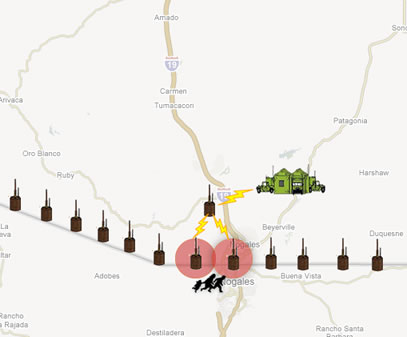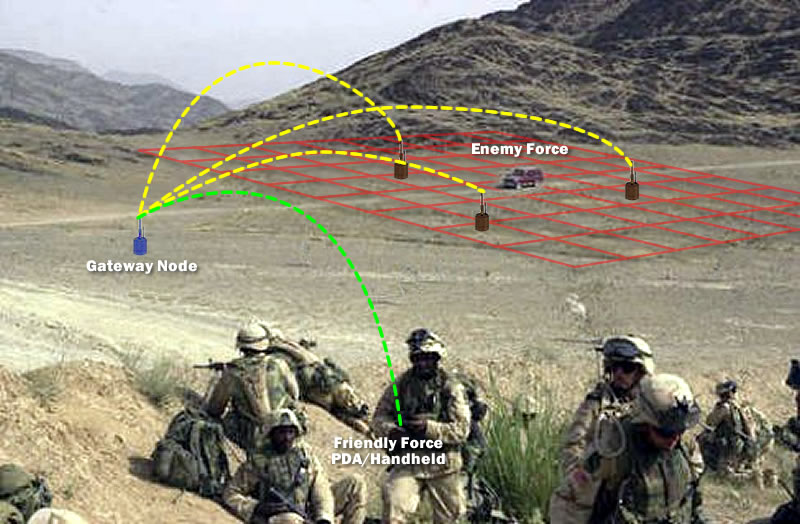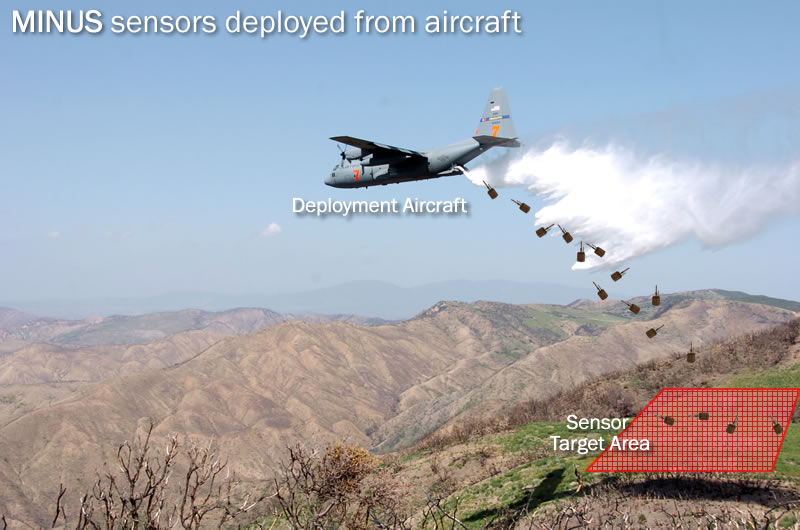Welcome!
This is the web site for the Unattended Ground Sensors (UGS) project. This project was completed for the Fall 2008 SEOR 798/680
Systems Engineering and Operations Research Applied Project Course class at George Mason University (GMU), taught by Dr. Thomas H. Speller.
Objective
The current methods for automated intrusion protection are expensive and/or time consuming. There is no efficient, low cost, and highly accurate method to locate and detect intrusion. The UGS team seeks to evaluate methods and technologies to determine the best and most effective operational design for a new UGS platform. This project includes a feasibility study and an initial design for an intrusion detection system with emphasis on wireless communications and mote technologies.
For more information on this project, please click on respective links on our website!
View an interactive demonstration!
|
 |
Problem Statement
In order to detect personnel and motorized open ground intrusions at a minimal cost, the US Government and Military need modernized detection methods that are user friendly, efficient and accurate. Currently fences and border patrol personnel are used extensively to secure our nations borders. These intrusion prevention methods come at a high cost/covered area, and provide no autonomous "24/7" surveillance. One solution is to utilize unattended ground sensors in support of surveillance and force protection. UGS are used as tactical surveillance barriers to monitor disputed borders or as force protection devices to notify of enemy presence. Although there are UGS systems on the market and in use, very few can provide the capability of rapid deployment, extended operational life, small physical footprint (mote technology), low cost and up-to-date technologies. Without an effective open ground intrusion detection system, personnel and motorized intrusions will continue to be a major threat to military troops as well as civilians in certain border regions in the United States.
Proposal
Operational Diagrams
Military Mockup

Plane Deployment

|
System Design Specification
Requirements Traceability Matrix
Team Members
Shirin Aminifar
Shirin is in the Systems Engineering Master's degree program at George Mason University. Her focus in this discipline is Systems Management. She has an undergraduate degree in Electrical Engineering also from George Mason (graduated May, 2002). Shirin has been working at Booz Allen Hamilton for the past 6 years as a consultant providing Test and Evaluation (T&E) support to many clients including Army, Air Force and other Joint DoD agencies. Shirin is currently an Associate at Booz Allen Hamilton with more than 6 years of hands-on experience in Systems Engineering and Test and Evaluation (T&E). Her technical expertise is focused in the areas of software testing, satellite and hybrid communications systems, communications planning tool operations, test management and planning, developmental and operational testing, quality assurance, requirements definition and verification, automated testing, web service testing as well Identity Management enterprise implementations. Her interests primarily lie in project management and T&E.
Eddy Gerenski
Eddy is in the Systems Engineering Master's degree program at George Mason University. His focus in this discipline is Systems Management. Eddy has an undergraduate degree in Mechanical Engineering from Lehigh University (graduated May, 2003). Eddy currently works for Integrity Applications Incorporated (IAI) as a Senior Systems Engineer/Systems Integrator in support of US Government clients. Eddy has been actively working as a Systems Engineer for 5 years within the DoD community with emphasis on rapid acquisition, warfighter requirements definition, T&E and systems integration into operational environments. His past experience also includes Defense Acquisition University and Corporate training in Systems Engineering, Acquisition, Logistics, and Project Management. His interests primarily lie in Project Management and Systems Integration.
Amin Mehr
Amin is in the Systems Engineering Master's degree program at George Mason University. His focus in this discipline is Systems Management. Amin has an undergraduate degree in Electrical Engineering from The University of Virginia. Amin's previous work was for Northrop Grumman Electronic Systems where he was a Junior Systems Engineer for clients from the Navy and commercial ships. The DoD related work that he accomplished was with with emphasis on requirements definition, SRS development, systems testing, and COTS related products. His past experience also includes independent software testing systems for Northrop Grumman and the DoD community. He has also had experience in wireless networks and electrical contracting.. His interests primarily lie in contorl systems and renewable energies. Amin is currently considering continuing his education with a PhD. in systems engineering.
References



